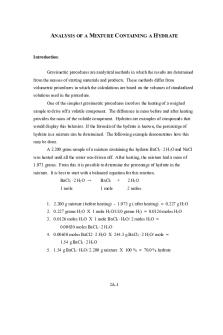Lab Experiment 2- Mass Conservation and Analysis of a Crystalline Hydrate PDF

| Title | Lab Experiment 2- Mass Conservation and Analysis of a Crystalline Hydrate |
|---|---|
| Author | Adam |
| Course | General Chemistry Ia Lab/Rec |
| Institution | University of Michigan-Dearborn |
| Pages | 6 |
| File Size | 616.5 KB |
| File Type | |
| Total Downloads | 23 |
| Total Views | 142 |
Summary
Lab experiment 2 ...
Description
Laboratory Report Experiment 2. Mass Conservation and Analysis of a Crystalline Hydrate Chem 134 Laboratory Section # ____________
Name: ______________________________ Date: ____________________
Chemistry 134
Experiment 2
Data and Results Part 1. Conservation of Mass Total mass before mixing: ____________________ Observation of 1st reaction, between 1.0 M CaCl2 and 1.0 M Na2CO3.
Write and balance a chemical equation for the 1st reaction using the following description: aqueous calcium chloride and aqueous sodium carbonate are mixed to produce aqueous sodium chloride and solid calcium carbonate
Total mass after 1st reaction: __________________ Is mass conserved in the first reaction?
Observation of 2nd reaction, between reaction products from above and 3 M H2SO4.
Write and balance a chemical equation for the 2nd reaction using the following description: solid calcium carbonate and aqueous sulfuric acid are mixed to produce solid calcium sulfate, liquid water, and gaseous carbon dioxide
Total mass after 2nd reaction: _______________ Is mass conserved for the second addition of reagents? If not, how could you verify mass conservation by modifying the procedure?
University of Michigan-Dearborn
27
Chemistry 134
Experiment 2
Part 2. Analysis of a Crystalline Hydrate Unknown Code ______________________ Table 1. Mass of empty crucibles. parameter
Crucible 1
Crucible 2
mass empty crucible (g)
Table 2. Mass unknown before heating. parameter
Sample 1
Sample 2
mass crucible + unknown (g) mass empty crucible (g) from Table 1
mass unknown (g)
Observation. Appearance of the sample in the crucible before heating.
Table 3. Mass anhydrous unknown and crucible. parameter
Crucible 1
Crucible 2
1st heating mass (g) 2nd heating mass (g) 3rd heating mass (g) 4th heating mass (g) mass crucible + anhydrous unknown (g)
Observation. Appearance of the sample in the crucible after heating.
University of Michigan-Dearborn
28
Chemistry 134
Experiment 2
Table 4. Mass anhydrous unknown. parameter mass crucible + anhydrous unknown (g)
Sample 1
Sample 2
from Table 3
mass empty crucible (g) from Table 1
mass anhydrous unknown (g) Table 5. Mass of water lost. parameter
Sample 1
Sample 2
mass unknown (g) from Table 2
mass anhydrous unknown (g) from Table 4
mass water lost (g) Calculate the %hydration in the unknown crystalline hydrate for each sample. Calculate the average value for the %hydration. Show all work. Sample 1
Sample 2
Average
Calculate the %hydration for each common crystalline hydrate and complete the table. formula
%hydration
KAl(SO4)2·12H2O
Show the calculation for the %hydration of green vitriol.
CuSO4·5H2O MgSO4·7H2O FeSO4·7H2O CaSO4·2H2O Na2CO3·H2O University of Michigan-Dearborn
29
Chemistry 134
Experiment 2
Research the color of each crystalline hydrate in Table 2 in the procedure and the color of its corresponding anhydrous salt. Complete the table. formula of hydrate
color of hydrate
formula of anhydrous salt
color of anhydrous salt
KAl(SO4)2·12H2O CuSO4·5H2O MgSO4·7H2O FeSO4·7H2O CaSO4·2H2O Na2CO3·H2O Identify the unknown based on the average value for its %hydration and its appearance, both before and after heating. Select from the compounds provided in Table 2 in the procedure. Explain your choice.
Calculate the relative error(%) of the experimental %hydration.
List one possible source of error that may lead to a high value for %hydration.
List one possible source of error that may lead to a low value for %hydration.
University of Michigan-Dearborn
30...
Similar Free PDFs

Conservation of Energy Lab
- 10 Pages

Conservation of Energy Lab
- 8 Pages

Conservation of Energy lab
- 8 Pages

Conservation of Momentum Lab
- 5 Pages
Popular Institutions
- Tinajero National High School - Annex
- Politeknik Caltex Riau
- Yokohama City University
- SGT University
- University of Al-Qadisiyah
- Divine Word College of Vigan
- Techniek College Rotterdam
- Universidade de Santiago
- Universiti Teknologi MARA Cawangan Johor Kampus Pasir Gudang
- Poltekkes Kemenkes Yogyakarta
- Baguio City National High School
- Colegio san marcos
- preparatoria uno
- Centro de Bachillerato Tecnológico Industrial y de Servicios No. 107
- Dalian Maritime University
- Quang Trung Secondary School
- Colegio Tecnológico en Informática
- Corporación Regional de Educación Superior
- Grupo CEDVA
- Dar Al Uloom University
- Centro de Estudios Preuniversitarios de la Universidad Nacional de Ingeniería
- 上智大学
- Aakash International School, Nuna Majara
- San Felipe Neri Catholic School
- Kang Chiao International School - New Taipei City
- Misamis Occidental National High School
- Institución Educativa Escuela Normal Juan Ladrilleros
- Kolehiyo ng Pantukan
- Batanes State College
- Instituto Continental
- Sekolah Menengah Kejuruan Kesehatan Kaltara (Tarakan)
- Colegio de La Inmaculada Concepcion - Cebu











